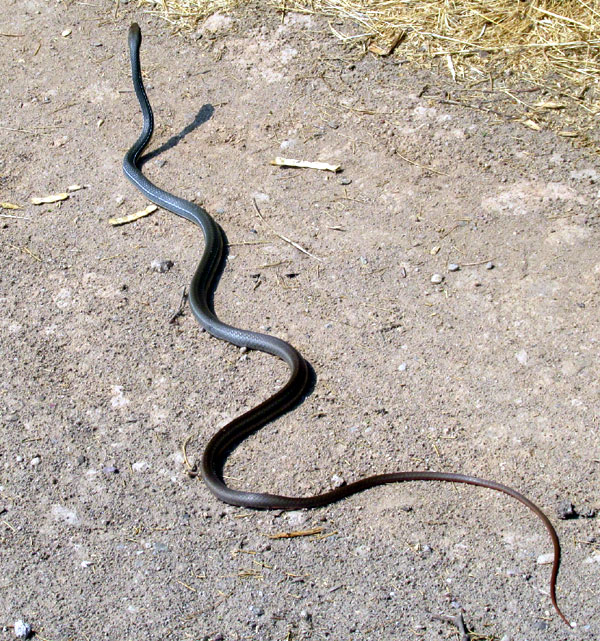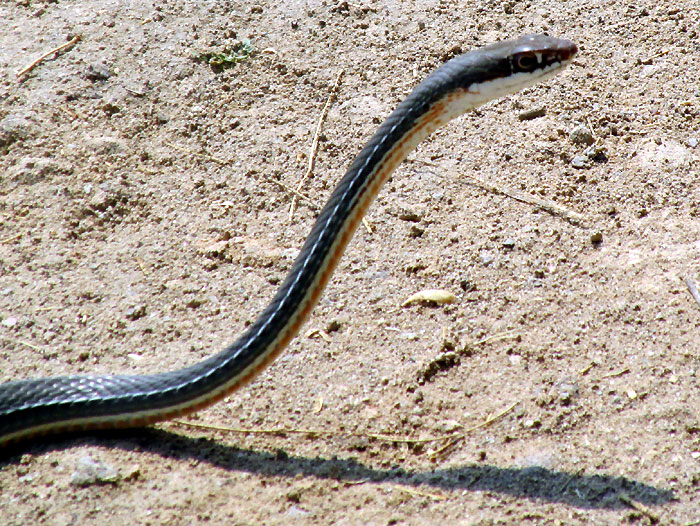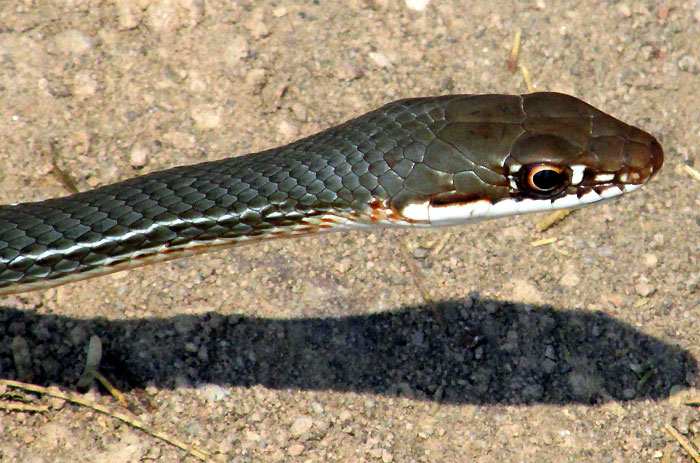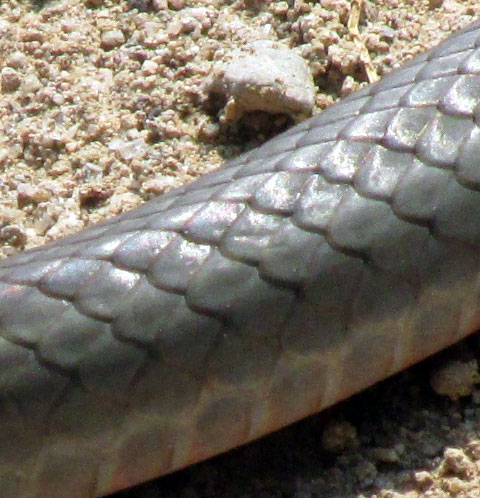Excerpts from Jim Conrad's
Naturalist Newsletter
entry dated May 25, 2022, issued from near Tequisquiapan, elevation about 1,900m (6200 ft), ~N20.57°, ~ W99.89°, Querétaro state, MÉXICO
WHIPSNAKE ON THE ROAD

Along a dirt road across a valley with flat fields, some abandoned, others fallowing here at the parched, dusty climax of the dry season, the above snake turned up, not scurrying away at my approach. During seven dry-season months of daily hiking these roads I'd not seen a single snake, so this was special. I assume that the poverty of snakes is the natural consequence of centuries of machete-carrying Mexican farmers and shepherds walking these same roads quite sure that 90% of the snakes they see are deadly venomous.
The snake was about 1.3m long (4ft), and its most obvious field mark was its exceeding slenderness, the small head and long, slowly tapering tail. It didn't seem shy at all, letting me walk around to the side for a close-up of the raised head, shown below:

When I drew closer, still it didn't move away, though the head was lowered as if flight were being considered:

For identification purposes, the above is an important picture, because it shows the configuration of scales atop and along the side of the head. On our Snake Identification page you can see how each scale on a snake's face has its own name and relative size and position to other scales. These features change from species to species, but are fairly constant within a species.
Details of scales on the body are important, too, especially because snake color and patterning isn't nearly as constant within a species as scale details are. Mainly, it's important to note how many lines of scales run along the sides of the snake at mid length, plus whether each scale displays a slender rib-like ridge running lengthwise. Scales with ridges are said to be "keeled." Garter snakes and rattlers have keeled scales, rat snake scales are weakly keeled, and king snakes and racers possess smooth ones.

The above picture shows smooth scales, no keels at all. That wasn't surprising, because already the snake's length and extreme slenderness had suggested that it was a species of racer or close to the racers, and racers bear smooth scales. However, there's a whole cluster of racer and racer-like species, so details of the face scales also were needed.
In fact, this snake seemed even more slender than most racers, and we'd run into a similar species in arid southwestern Texas, the Coachwhip Snake, Masticophis flagellum. Checking to see if Masticophis species occur in Mexico's Querétaro state led to pictures matching our snake. Here we have the Schott's Whipsnake, MASTICOPHIS SCHOTTI.
In 2019, Rubén Alonso Carbajal-Márquez and others published a report entitled "New Prey Item in the Diet of Masticophis schotti Baird & Girard, 1853, from San Luis Potosí, Mexico," in which details of the species were outlined. There we learn that Schott's Whipsnake is distributed from central Texas south through the Gulf coastal plains to central Veracruz, Mexico, and in the arid Mexican uplands south to Hidalgo and Michoacán, so here we're at the southern extreme of its distribution. Within the species two subspecies are recognized, and ours is subspecies ruthveni, which occurs from the southernmost tip of Texas to our area.
Carbajal-Márquez describes Schott's Whipsnake as foraging during the day, with it head and forebody raised above the ground. He quotes a 2000 study by Camper & Dixon in which 316 museum specimens of the species were examined, of which only 5% had food in their stomachs. That food consisted of 78% lizards and 22% mammals.
Our Schott's seemed to have an empty stomach, and maybe that's why he was foraging out among flat fields, some of them just burnt black and lifeless, a few others recently plowed, the rest with sparse weeds -- not the best places for lizards. Maybe he was looking for decent hunting territory, but at the moment, just couldn't find any.